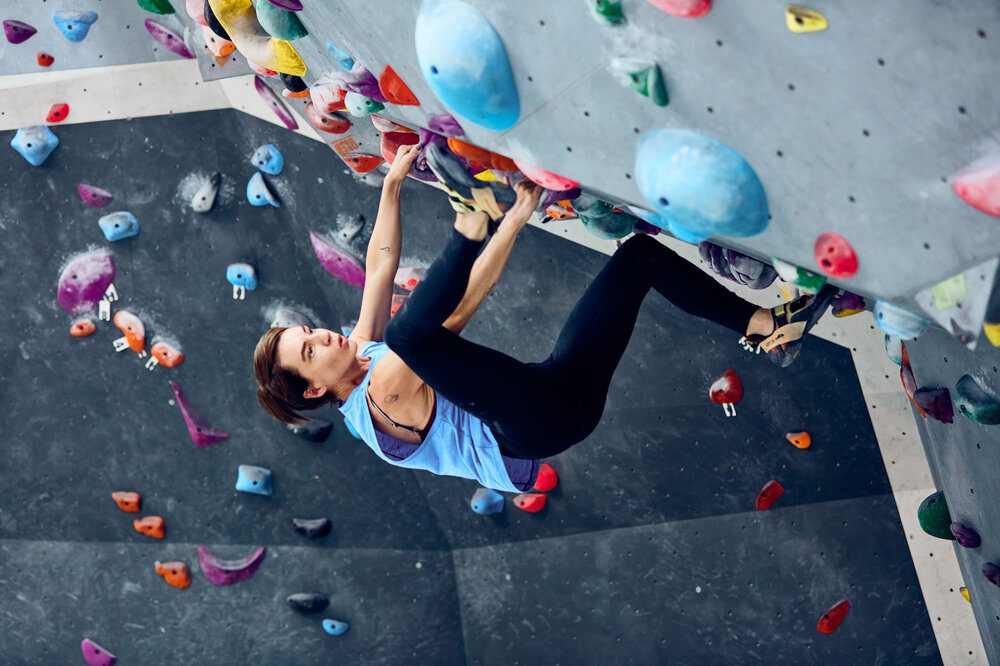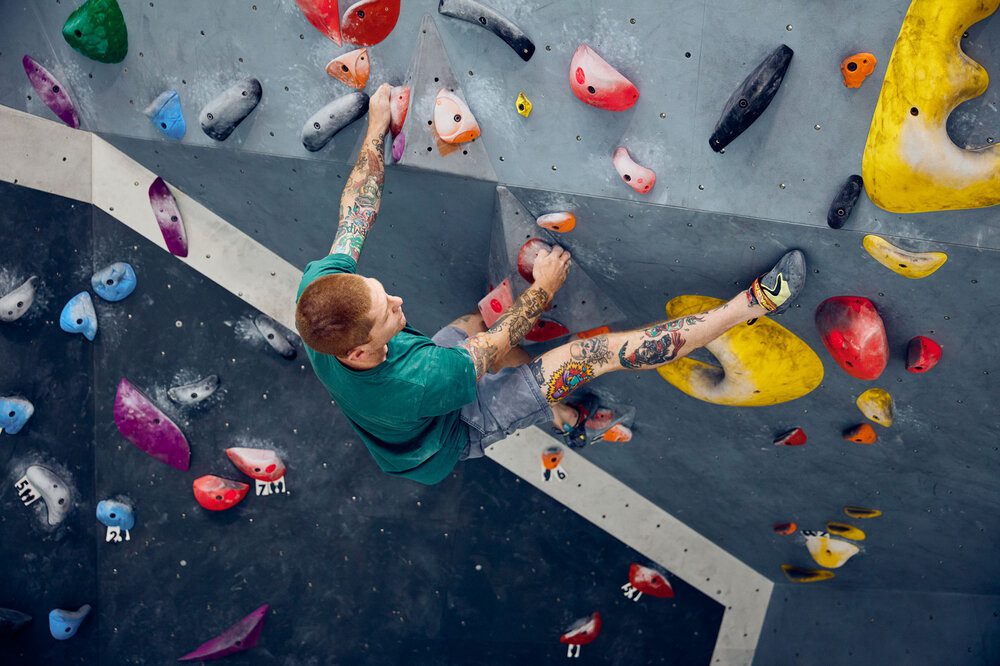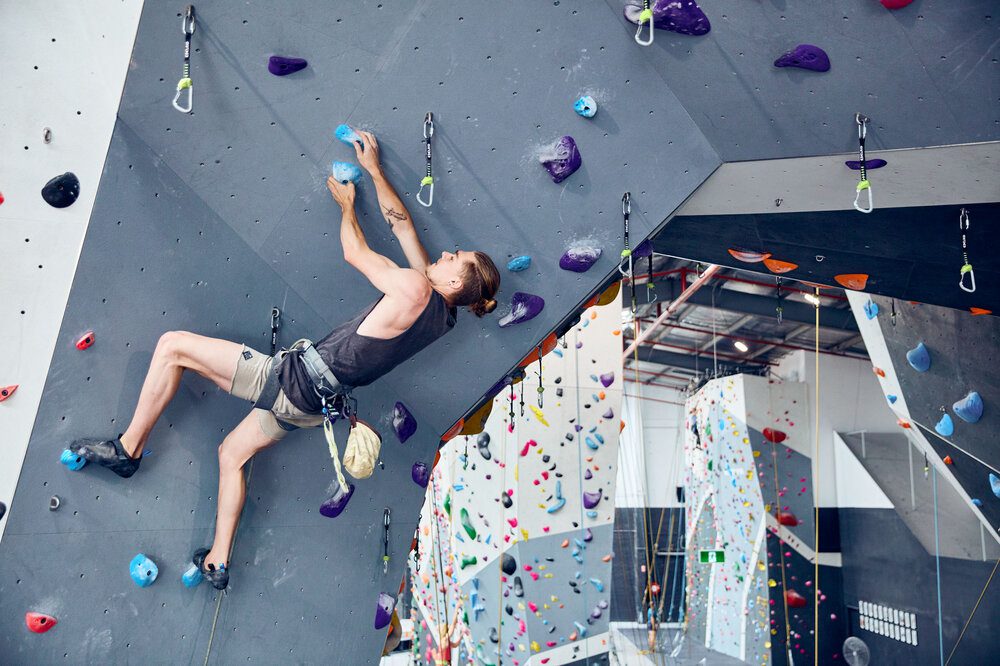
For all avid climbers out there, the idea of going another period of weeks or months without getting back to the climbing wall is pretty disheartening. Like all athletes around the world, climbers want to get back to doing the sports we love; there’s no doubt we are all feeling the slump of quarantine getting to us. With climbing centres temporarily closed for the time being, it’s hard to see how our moods could be lifted.
Never fear, though! Read on to find out how your body will re-adjust to your regular climbing routine in no time. Our muscles are amazing things, and you’re about to find out just how incredible they really are.
Climbing is a compound exercise, meaning you utilise multiple muscle groups at once when you climb. As well as being tough on the hands and feet, climbing builds unbelievable muscle strength. In order to keep yourself holding onto the wall, your core must be engaged at all times. Think of it like a plank - but planking while you’re also pulling with your upper body and pushing with your lower body. Pretty badass, no?
Especially within their first few months of intense climbing training, a person will likely gain muscle mass and lose body fat from their sessions on the wall. Climbers aren’t likely to build excessive, bulky muscle, like weightlifters do, but rather will stay toned, lean and firm if they continue to climb often.
We’re all missing that post-climb exhilaration, but not to worry. Before we know it, we’ll be back to it, and these times will feel far away behind us.
Having a break from climbing might seem difficult, but this period of rest can be used to become more mentally resilient. Sometimes, in engaging our mental capabilities, we can return to physical strength training with a newfound appreciation for sport and physical exertion!
That being said, many sportspeople are super concerned about their progress when they return to their sport after quarantine. Even if you’ve been enjoying our home workout videos, when you’re used to scaling 40ft walls with your bare hands, it doesn’t quite feel the same!
Looking in the mirror, you might have noticed that your previously toned muscles appear to have shrunk, or even disappeared completely, with the lack of rigorous exercise. So the question on every climber’s lips is: will all my hard work over the past months or years be gone forever?
Our ability to return to our personal best is not just mind over matter - it actually has to do with our molecular structure, and it’s down to a phenomenon called muscle memory. Yes, muscle memory, that famous thing that’s most commonly used to mean not forgetting how to do something, is actually ingrained in our DNA!
You might think that your muscle memory only applies to riding a bike, or driving a car; no matter how many years it’s been, you’ll never forget how to do it. But muscle memory is so much more than that, and it just might save your bacon when you return to the climbing wall.
In science, there has been an age-old debate about muscle memory. Is it really a ‘thing’? Does it really affect your ability to get back to the sport you love after some time? Can your muscle cells really remember their past abilities? Is it really that important to maintain your fitness while you’re quarantined? The science behind muscle memory can be confusing and difficult to understand - so we’re going to break it down for you!
Here’s our 8-step explanation of muscle memory. Buckle up and put on your goggles, it’s about to get scientific in here.

No, your muscles don’t literally have a memory. Instead, the ‘memory’ refers to the cells inside your muscles, which are different to cells in the rest of your body. The difference between muscle cells and other cells is that muscle cells have multiple nuclei, known as myonuclei, whereas other cells only have one nucleus. (Yeah. We told you it was confusing. Stay with us.)
The nucleus of a cell is like the cell’s brain. So your muscle cells having myonuclei means that these guys have multiple ‘brains’, so they have greater capacity to control the chemical processes and growth of the cells! This allows the cells in your muscles to grow larger and more quickly than the other cells in your body. Think of them like the X Men of the cell world.
In order to produce myonuclei, your muscles take stem cells from other parts of your body - these particular stem cells are called satellite cells. Satellite cells are not from outer space, as it might sound, but they do have pretty wacky abilities. Satellite cells can essentially ‘donate’ their nuclei to your muscle cells, to allow them to grow faster and stronger than the other cells around them. They have a pretty raw deal, those satellite cells, but their job is absolutely essential when it comes to muscle memory.
Here’s when you come in. When you bear weight, either through weightlifting or sports like climbing, you actually break the fibres of your muscles. That phrase ‘feel the burn’ is more accurate than you realise - your muscles are kind of, sort of, tearing. Ouch. Sounds like a pretty bad idea, but it’s actually necessary in order for your muscles to grow and become stronger. No pain, no gain. Literally.
Once your muscle fibres are broken apart by training, that’s when your muscles call up the satellite cells for a rescue mission. The satellite cells hand over their nuclei, and the muscles repair themselves with even more power they had before. That’s why we see our muscles become larger and more defined the more we train. The more you train, the more your muscles can expand, grow and strengthen. Here’s where the memory part comes in.
What happens if you stop training? Quarantine life hit us pretty fast, and through no fault of our own, our regular routines stopped in their tracks. The satellite cells have rushed over, donated all their nuclei, helped your muscles out in their journey to the gains, and now it’s all for nothing? Wrong. Luckily, these myonuclei have your back. Once the satellite cell has donated its nucleus, it basically sticks around forever. There has been a lot of debate in science about the length of time your muscle will have this ‘memory’, but the general consensus is that it never really goes away. Awesome, right?
What this really means is that if you have a foundation of training, and have previously built muscle, even if those muscles appear to shrink away, the myonuclei remain. Which is great, because it means once you get back on the climbing wall, you are likely to build your original muscle mass back much more quickly than the first time around. Cool, right? Those myonuclei and satellite cells are there to make sure you’ll never really go back to square one.
So yes, you lucky thing, you won’t have to start your training from scratch when this madness is over. Instead, you’ll have a hoard of myonuclei, proteins at the ready, waiting to help you achieve your best climbs yet.
Reading a route is how climbers evaluate the task in front of them. when you plan and visualise your moves, the mind and body sync together to build a mental picture of the challenge ahead which in turn helps avoid frustration and in turn helps you conserve energy. we talk about this extensively in our earlier blog article ‘Learning how to read indoor rock climbing routes’.
‘Take note of all of the holds on your route. Visualise where you’ll be climbing and get a good feel for all of the difficult sections that you’ll need to think twice about. Once you go up, re-trace that route in your mind and try your best to get a good feel for the placement of all of the obstacles and components. If you fall, don’t get too frustrated. Simply learn from your mistakes and your experiences up on the climb and try to build a new route, strategy or use different movements to overcome those challenges.
One of the important terms to learn here is “beta”. In the world of rock climbing, beta is the word used to describe the information given from an experienced climber about a route. It can usually involve getting over certain obstacles and sections of the route or general advice on how to tackle it. This kind of advice is essential for helping you complete a route with no prior experience, and you can always consult a more experienced climber for “beta”.
When examining the route, try to visualise areas where you’ll be placing your hands and your feet. If you can’t quite come up with a solid route, don’t be afraid to ask someone for assistance or advice. After all, the components of a wall in a climbing gym aren’t naturally formed or place randomly. Each component has a purpose and is placed with meaning. This means that you should eventually be able to recognise the optimal hand and foot positions while climbing a route. One of the more important qualities to look out for is the angle and position of certain components on the wall.
you can read the full article on the Climb fit blog here

If you’re worried you’re losing strength over quarantine, at least now you know it’s not all bad news. Understanding muscle functions on a biological level allows us all to fully appreciate the magic of our bodies’ processes. Being able to fully grasp what our bodies do when we train, and how this process affects us for our entire lives, is an amazing thing. Talk about motivation to smash your training sessions! Knowing that every time you train, you are contributing to a lifelong bank of muscle definition, growth and health is something to always keep in mind when you’re feeling sluggish.
It’s even proven that these myonuclei, and the proteins they produce to repair your muscles, can help us more than just achieving peak fitness levels. If you are involved in an accident, or have to have surgery for any other reason, research shows you are much more likely to recover at a faster rate when you have these repair processes built in. Training your muscles to self-repair on a regular basis allows them to repair more easily, when there’s serious damage like surgery scarring. Who knew that while you were engaging in your favourite sports and getting strong, you were potentially doing your future self a huge favour.
All in all, try not to let quarantine blues get the better of you! Knowing that you’ll come back to training with your body on your side, will tide you over while sport is restricted. In the meantime, keep yourself healthy and well with good food, regular movement and a lot of laughter!